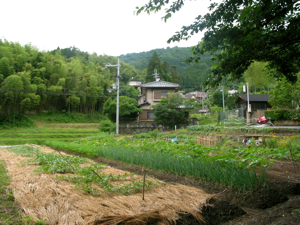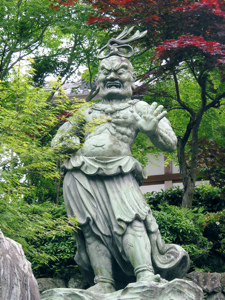About This Project:
It was 2005 when Shingu came up with the idea of establishing a
Kansai-ben self-study website. After some preparatory research and
after involving Hatanaka as a collaborator, this project
officially started in 2006 supported by
The Consortium of Language
Teaching and Learning. In this section, we will explain what is
behind this project; why we, ordinary Japanese instructors in the US,
decided to work on this project in addition to our school teaching
duties, and where we currently stand in terms of progress on this
project.
Being
native speakers of the Kansai dialect, we have been asked by a
number of intermediate level students of Japanese, who are ready to
participate in exchange/internship programs in the Kansai area, for
help in preparing them for their experience by teaching them the
dialect. Some students say their interest in the dialect grew from
watching animation and movies in which some characters speak the Kansai
dialect or from their Japanese friends who are native speakers of the
dialect.
 |
| 野菜畑 Vegetable field
(Oharano, Kyoto) |
As
explained in Chapter 1, Kansai-ben is the most powerful regional
dialect in Japan nowadays, spoken by over twenty million people
including those in Osaka, Kobe, Nara and Kyoto. Though the Kansai
dialect has linguistically distinctive features from Standard Tokyo
dialect, native speakers of Japanese are used to hearing it and usually
have little problem understanding it because the dialect is widely used
in the entertainment industry and in the media (by Kansai comedians,
for example). However, it is a challenge for foreign learners of
Japanese to comprehend it since only "standard" Japanese is taught in
the U.S. Most students never have a chance to realize the fact
that
there are big regional differences in how the Japanese language is
spoken; they tend to find out only after they go to Japan and
experience difficulty understanding what the local people are saying.
In the case of the
MIT Japan
program (MIT has a strong internship program, and most students
interested in going to Japan choose this over studying abroad),
approximately one fourth of the interns are sent to the Kansai area
each year. They do not receive detailed instruction on the regional
dialect during their preparation period. In the summer of 2005, Shingu
conducted an online survey targeting 21 interns who were sent to the
Kansai area between 2003 to 2005 to learn how they see the dialect and
if they feel studying the dialect beforehand would have been useful to
their internship. Their opinions varied depending on their background,
the work environment they were in and the amount of contact they had
with local people. Those who had a significant amount of contact with
local people, especially with elderly people, experienced difficulties
in proper understanding and felt they would have appreciated formal
instruction of the dialect beforehand. The result positively supports
our supposition regarding the need to study the dialect among the
participants.
Up to now, it has only been possible to offer a seminar or an
extra-curricular activity on the basics of the Kansai dialect. At the
Japanese School at Middlebury College, VT, Shingu conducted weekly
Kansai-ben seminars as an extra-curricular activity in the summers of
2001 to 2003 due to the demand from the students. As much as twenty
percent of the Japanese students participated in the seminar each
summer. At the University of Texas at Austin, Hatanaka spends one hour
of the third year Japanese course introducing the dialect to increase
the awareness of this regional language and culture in Japan.
However, these are very limited examples at a limited number of
institutions. This amount of instruction is far from adequate for
answering the students’ need to learn the dialect in a systematic and
practical manner.
Textbooks
and web resources related to Kansai-ben are also presently
insufficient. There is a textbook on the Kansai dialect written by
Japanese teachers in Japan accompanied by tapes. However, there are a
few problems: 1) its medium language is Japanese; hence, while it may
be good for advanced learners, it is not suitable for most students who
have only 2-3 years of Japanese study, and 2) the order of introducing
each structure is not systematic and, therefore, it is very hard to
find what is introduced where. The biggest problem is that the book has
recently gone out-of-print! There are also a couple books on the Kansai
dialect published in the U.S. However, these are not written by
Japanese teachers who are familiar with teaching Japanese as a foreign
language, and there is no audio resource to go along with them. We also
found a few English websites and some Japanese websites focusing on the
Kansai dialects. However, none have been created/maintained by
professional Japanese teachers. These websites may be useful to gain
knowledge of the overall feature of the dialect or some idioms, but not
for practical comprehension of or communication with the dialect.
Japanese websites are meant for Japanese natives, not for Japanese
learners, so they are out of the question as far as comprehensive
learning for non-native speakers is concerned.
 |
| 正法寺の不動尊 Fudo at
Shobo-ji Temple (Kyoto) |
Therefore,
it would be reasonable for Japanese teachers as pedagogical
specialists to create an accessible and practical online tool to learn
the dialect, specifically for Intermediate Japanese learners and in the
medium of English. There are three reasons why a website would be ideal
to conduct this project: 1) Websites can be accessible to any student
practically anywhere and anytime, 2) Websites are capable of embedding
sound and visual information in addition to the factual texts and
written exercises, and 3) Websites can be an open-end resource to which
we can add and edit exercises and materials whenever necessary.
Websites
can also make use of video-clips featuring natural
conversation by native dialect speakers for listening comprehension and
as cultural resources. Since the study of the dialect is something
students would do in addition to their standard Japanese study, it
should be relatively non-demanding; that is, it has to be something
they could have fun with and something that could enhance their
curiosity to continue working on it. The video-clips of “real people”
should contribute to make the exploration of the Kansai dialect and
culture more realistic and enjoyable. Also, video-clips can show the
diversity within the dialect – for instance, Kansai people of different
gender, generations, and in different regions speak differently within
the category of the dialect. Furthermore, video-clips can provide rich
visual information in addition to the sounds, such as the situation,
location, scenery and appearance and manner of the people. Not only can
the users learn and develop a strong feeling for the cultural practice
of the spoken language in Kansai but they can also cultivate their own
idea on what “Kansai culture and local identity” is.
As of July 2007, we have uploaded chapters 1, 2, 3 and a part of
Chapter 6. Tremendous efforts have been made to come this far, since
all the materials (English texts, example sentences, exercises, audios
and video clips) were created by the two of us--Shingu and
Hatanaka--with little knowledge of web publishing. There are still many
things to be done: site-design and
uploading the rest of the chapters, to name a couple. Through the
survey to pilot users in June 2007, we received many encouraging
comments, suggestions and new ideas that we can certainly adapt to make
the site more user-friendly. Fortunately, we received additional
funding from the Consortium of Language Teaching and Education in 2007,
and this will allow us to continue making the website more complete and
updated.
*As of April 2008, we have added some contents of chapters 4, 5 and 7.
We also added sound files for standard Japanese phrases in chapter 2 so
users can compare the sound difference between standard and kansai
(many thanks to Mayumi Ishida, our collaborator,
for her assistance as a naive Tokyonite)


